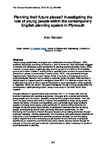Planning their future places? Investigating the role of young people within the contemporary English planning system in Plymouth
| dc.contributor.author | Bertram, A. | |
| dc.date.accessioned | 2019-07-24T11:39:55Z | |
| dc.date.available | 2019-07-24T11:39:55Z | |
| dc.date.issued | 2019 | |
| dc.identifier.citation |
Bertram, A. (2019) 'Planning their future places? Investigating the role of young people within the contemporary English planning system in Plymouth', The Plymouth Student Scientist, 12(1), p. 345-395. | en_US |
| dc.identifier.uri | http://hdl.handle.net/10026.1/14691 | |
| dc.description.abstract |
Despite young people being the longest-term stakeholders in society (Simpson, 1997), academic discourses promoting the benefits of youth involvement have historically struggled to translate into widespread youth participation in planning practice (Knowles-Yanez, 2005). However, in recent years, English planning reforms (as part of the 2010 to 2015 Coalition government’s wider ‘Localism’ and Big Society’ agendas) have provided an unprecedented devolution of powers to communities (Tewdwr-Jones, 2012), most prominently through Neighbourhood Plans (Norton and Hughes, 2018). In contrast to increasing amounts of youth participation literature from a variety of countries across the globe, there has been a relative dearth of England-specific investigation since 2010. It is therefore unclear how the English planning reforms have impacted the practice of youth participation, either positively or negatively. Within this context, this paper investigates the role of young people within the contemporary English planning system, using a case study of Plymouth, South-West England. Through utilisation of questionnaires and workshops with 11- to 16-year-olds, and key informant interviews with planning practitioners, this paper aims to understand whether young people have the interest, capability and potential to shape better places. From this work, this paper finds a wide variety of interest and capabilities amongst young people. Despite this variety of interest and capabilities, and a potentially large target audience capable of shaping better places, youth participation is found to still be extremely low amongst the sample group. Many barriers to participation were self-identified by young people, encompassing several topics previously discussed academically, but also introducing the importance of lesser-discussed issues such as raising awareness through improved marketing. Planning practitioners from the private- and public-sectors identified the importance of youth perspectives in planning processes, although the ever-increasing viability requirements when conducting any participation events were also emphasised. Significantly for academics, practitioners and policy-makers, lessons learned through the example of Plymouth are used to discuss future avenues for viably increasing the uptake of youth participation in planning. | en_US |
| dc.language.iso | en | en_US |
| dc.publisher | University of Plymouth | en_US |
| dc.rights | Attribution 3.0 United States | * |
| dc.rights.uri | http://creativecommons.org/licenses/by/3.0/us/ | * |
| dc.subject | contemporary English planning system | en_US |
| dc.subject | Localism | en_US |
| dc.subject | Big Society | en_US |
| dc.subject | youth participation in planning | en_US |
| dc.subject | Cross-tabulation | en_US |
| dc.subject | Chi Square | en_US |
| dc.subject | Statistical analysis | en_US |
| dc.title | Planning their future places? Investigating the role of young people within the contemporary English planning system in Plymouth | en_US |
| plymouth.issue | 1 | |
| plymouth.volume | 12 | |
| plymouth.journal | The Plymouth Student Scientist |



